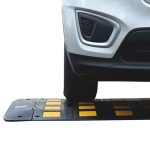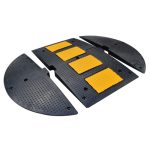Explanation of traffic calming
Traffic calming is a term used to describe a range of measures designed to slow down traffic and make roads safer for all users. The aim of traffic calming is to reduce the speed of vehicles, which in turn reduces the likelihood of accidents and improves the overall safety of the road. There are many different types of traffic calming measures, including speed humps, chicanes, and roundabouts. Rubber speed bumps are one of the most effective and popular forms of traffic calming, as they are easy to install, cost-effective, and highly visible. They are also durable and can withstand heavy traffic, making them ideal for use in busy areas.
Importance of traffic calming
Traffic calming is an essential aspect of road safety that aims to reduce the speed of vehicles and improve the overall safety of pedestrians and motorists. It is particularly crucial in areas with high pedestrian traffic, such as schools, hospitals, and residential areas. By using rubber speed bumps for traffic calming, drivers are forced to slow down, reducing the risk of accidents and improving the overall safety of the area. Rubber speed bumps are an effective and affordable solution for traffic calming, making them an ideal choice for communities looking to improve road safety.
Introduction to rubber speed bumps
Rubber speed bumps are a popular traffic calming solution that are widely used in residential areas, parking lots, and other areas where speed control is necessary. These speed bumps are made from durable rubber materials that can withstand heavy traffic and harsh weather conditions. Unlike traditional speed bumps made from concrete or asphalt, rubber speed bumps are more flexible and can be easily installed and removed. They are also more cost-effective and environmentally friendly than other types of speed bumps. In this article, we will explore the benefits of using rubber speed bumps for traffic calming and why they are a great option for communities looking to improve safety on their roads.
Advantages of Rubber Speed Bumps
Cost-effective
Cost-effective: One of the biggest advantages of using rubber speed bumps for traffic calming is their cost-effectiveness. Compared to other traffic calming measures such as speed humps or roundabouts, rubber speed bumps are much cheaper to install and maintain. They require minimal labor and equipment to install, and can be easily removed or relocated if necessary. Additionally, rubber speed bumps have a longer lifespan than traditional asphalt speed bumps, reducing the need for frequent replacement. This makes them an ideal choice for municipalities and businesses looking for an affordable and efficient way to control traffic speed and improve safety on their roads.
Easy to install
One of the major advantages of rubber speed bumps is their ease of installation. Unlike traditional concrete speed bumps, rubber speed bumps can be installed quickly and easily without the need for heavy machinery or specialized equipment. They can be easily installed by a small team of workers using basic tools, making them a cost-effective solution for traffic calming. Additionally, rubber speed bumps can be easily removed or repositioned if necessary, making them a flexible option for temporary traffic control measures. Overall, the ease of installation of rubber speed bumps makes them a popular choice for municipalities, schools, and businesses looking to improve traffic safety.
Durable and long-lasting
Rubber speed bumps are known for their durability and long-lasting nature. Unlike traditional asphalt speed bumps, rubber speed bumps are resistant to weather conditions such as extreme heat, cold, and moisture. They are also resistant to oil and other chemicals that may be present on the road. This means that they can withstand heavy traffic and frequent use without deteriorating quickly. Additionally, rubber speed bumps are easy to maintain and can be cleaned easily with soap and water. This makes them a cost-effective solution for traffic calming measures as they do not require frequent replacement or maintenance.
Low maintenance
One of the biggest advantages of using rubber speed bumps for traffic calming is their low maintenance requirements. Unlike traditional asphalt speed bumps, rubber speed bumps do not crack or deteriorate over time, which means they do not require frequent repairs or replacement. Additionally, rubber speed bumps are resistant to weather and UV rays, which means they can withstand harsh outdoor conditions without fading or becoming brittle. This makes them a cost-effective solution for traffic calming, as they require minimal upkeep and can last for many years.
Effective in reducing speed
Rubber speed bumps are highly effective in reducing speed and controlling traffic flow. These speed bumps are designed to slow down vehicles to a safe speed limit, making them ideal for use in areas where pedestrian safety is a concern. Unlike traditional speed bumps made of concrete or asphalt, rubber speed bumps are more flexible and can be easily installed on any surface. They are also more durable and require less maintenance, making them a cost-effective solution for traffic calming. By slowing down traffic, rubber speed bumps can help prevent accidents and improve overall road safety.
Less noisy compared to traditional speed bumps
Rubber speed bumps are also less noisy compared to traditional speed bumps. Traditional speed bumps are made of concrete or asphalt, which can produce a loud noise when vehicles pass over them. This can be particularly bothersome for residents living near busy roads or in areas with high traffic volume. Rubber speed bumps, on the other hand, are designed to absorb the impact of vehicles passing over them, resulting in a quieter ride. This makes them a more desirable option for areas where noise pollution is a concern. Additionally, the reduced noise level can also help to reduce stress levels for drivers and passengers, making for a more pleasant driving experience.
Less damage to vehicles
Rubber speed bumps are designed to be more forgiving to vehicles than traditional speed bumps made of concrete or asphalt. The flexible nature of rubber allows the speed bump to compress under the weight of a vehicle, reducing the impact and potential damage to the vehicle’s suspension and tires. This not only saves drivers from costly repairs but also reduces the wear and tear on emergency vehicles and public transportation. Additionally, rubber speed bumps are less likely to cause damage to low-riding vehicles or vehicles with low clearance, making them a safer option for all drivers on the road. Overall, the use of rubber speed bumps can help to minimize the negative impact of traffic calming measures on vehicles while still effectively slowing down traffic in high-risk areas.
Environmentally friendly
Rubber speed bumps are also environmentally friendly. Unlike traditional asphalt speed bumps, rubber speed bumps are made from recycled materials and are fully recyclable themselves. This means that they have a much lower carbon footprint than their asphalt counterparts. Additionally, rubber speed bumps are designed to be more durable than asphalt speed bumps, meaning they need to be replaced less frequently, further reducing their environmental impact. By choosing rubber speed bumps for traffic calming, communities can not only improve safety on their roads but also reduce their impact on the environment.
Applications of Rubber Speed Bumps
Residential areas
Residential areas are one of the most common places where rubber speed bumps are used for traffic calming. These areas are typically characterized by low-speed limits and high pedestrian traffic, making them ideal for the installation of speed bumps. Rubber speed bumps are particularly effective in residential areas because they are less harsh on vehicles than traditional concrete speed bumps, which can cause damage to cars and create noise pollution. Additionally, rubber speed bumps are more visually appealing and can be customized to match the surrounding environment, making them a popular choice for residential communities. Overall, the use of rubber speed bumps in residential areas can help to reduce speeding and improve safety for both drivers and pedestrians.
School zones
School zones are one of the most important areas where traffic calming measures are necessary. Rubber speed bumps can be particularly effective in these areas as they help to slow down drivers and reduce the risk of accidents. In addition, rubber speed bumps are durable and can withstand heavy traffic, making them ideal for use in school zones where there is a high volume of vehicles. By using rubber speed bumps in school zones, we can create a safer environment for children and ensure that they can get to and from school without any incidents.
Parking lots
Rubber speed bumps are also highly effective in parking lots. They can be strategically placed to slow down drivers and prevent accidents in areas with heavy pedestrian traffic. Additionally, they can help to regulate the flow of traffic and prevent drivers from speeding through the parking lot. Rubber speed bumps are also easy to install and maintain, making them a cost-effective solution for parking lot owners and managers. Overall, the use of rubber speed bumps in parking lots can greatly improve safety and reduce the risk of accidents.
Industrial areas
In industrial areas, rubber speed bumps are particularly useful for traffic calming. These areas often have heavy machinery and large trucks moving around, making it crucial to maintain a safe speed limit. Rubber speed bumps are durable enough to withstand the weight of these vehicles and can effectively slow down traffic without causing damage to the vehicles or the speed bumps themselves. Additionally, rubber speed bumps are easy to install and can be removed or relocated if necessary, making them a flexible solution for industrial areas that may need to adjust their traffic flow over time. Overall, rubber speed bumps are an effective and practical solution for traffic calming in industrial areas.
Hospitals and healthcare facilities
Hospitals and healthcare facilities are places where safety and efficiency are of utmost importance. Rubber speed bumps can help to ensure that patients, visitors, and staff can move around the facility safely and smoothly. By slowing down traffic, rubber speed bumps can reduce the risk of accidents and injuries, particularly in areas where pedestrians are likely to be present. Additionally, rubber speed bumps are quieter than traditional speed bumps, which can be beneficial in hospital environments where noise levels need to be kept to a minimum. Overall, using rubber speed bumps in hospitals and healthcare facilities can help to create a safer and more comfortable environment for everyone.
Commercial areas
Commercial areas are often bustling with activity, with vehicles constantly coming and going. This can create a dangerous environment for pedestrians and drivers alike. Rubber speed bumps are an effective solution for traffic calming in these areas. They can slow down vehicles and reduce the risk of accidents, while also providing a clear indication to drivers that they are entering a high-traffic area. Additionally, rubber speed bumps are durable and long-lasting, making them a cost-effective choice for commercial areas that require frequent traffic calming measures. Overall, the use of rubber speed bumps can greatly improve the safety and efficiency of commercial areas.
Conclusion
Summary of benefits
In summary, rubber speed bumps offer numerous benefits for traffic calming. They are cost-effective, easy to install, and require minimal maintenance. Rubber speed bumps are also durable and weather-resistant, making them suitable for use in various climates. Additionally, they are highly visible and effective in reducing vehicle speeds, improving safety for pedestrians and motorists alike. Overall, rubber speed bumps are an excellent choice for traffic calming measures in residential areas, parking lots, and other locations where speed control is necessary.
Recommendation for using rubber speed bumps
When using rubber speed bumps for traffic calming, it is important to consider the placement and spacing of the bumps. They should be placed in areas where drivers are likely to be traveling at high speeds, such as near schools, parks, and residential areas. The spacing between the bumps should also be carefully considered to ensure that they are effective in slowing down traffic without causing discomfort or damage to vehicles. Additionally, it is important to regularly inspect and maintain the speed bumps to ensure that they remain in good condition and continue to effectively slow down traffic. By following these recommendations, rubber speed bumps can be a highly effective tool for traffic calming and improving safety on the roads.
Future of traffic calming
The future of traffic calming is promising, as more and more cities are recognizing the benefits of using rubber speed bumps. With advancements in technology, these speed bumps can now be designed to be more durable and effective than ever before. Additionally, there is a growing trend towards incorporating traffic calming measures into urban planning and design, which will help to create safer and more livable communities. As we continue to prioritize pedestrian and cyclist safety, rubber speed bumps will undoubtedly play a key role in achieving these goals.
Next Steps: If you’re interested in implementing rubber speed bumps for traffic calming in your community or business, consider reaching out to Unimat Industries. They offer a variety of high-quality rubber speed bumps that are durable, easy to install, and effective in slowing down traffic. By taking this step, you can help improve safety and reduce accidents on your property or in your neighborhood. Visit their website today to learn more and place your order.





